Updated: December 16, 2025 • By Santorini Dave
My Favorite Hotels in Naples
• 5-star: De Bonart
• 4-star: Santa Chiara
• 3-star: SuperOtium
• For couples: De Bonart
• For families: Vesuvio
• Best view: Vesuvio
• Best pool: Royal Continental
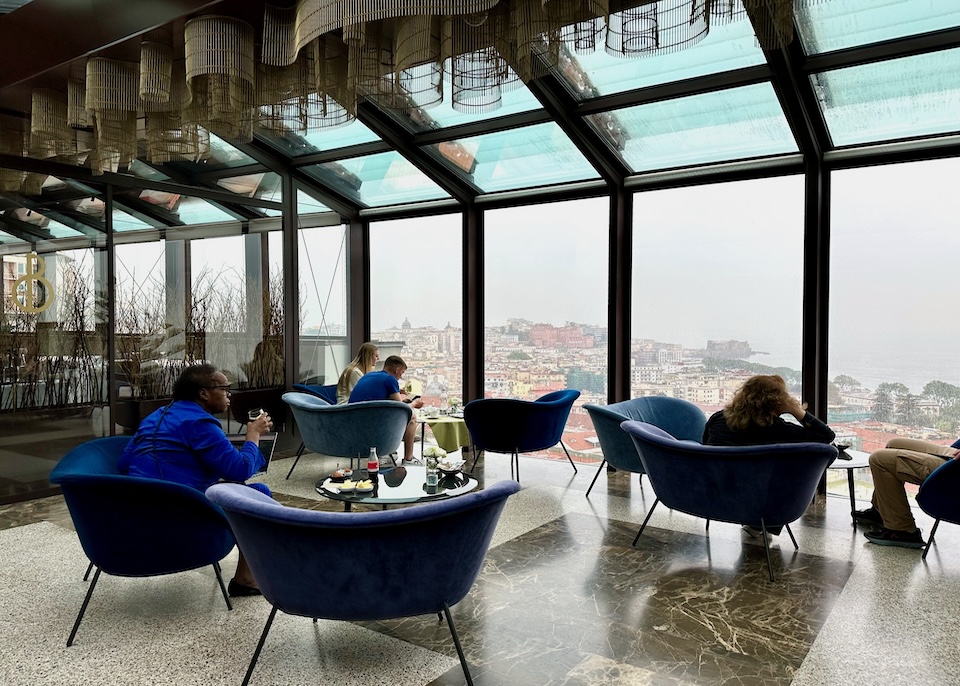
Floor-to-ceiling, wall-to-wall windows in the top floor bar at De Bonart in Naples.
Naples (Napoli) is intense, chaotic, and utterly magnificent. As Italy’s third-largest city, it sits about 190 km south of Rome and serves as the primary gateway to the south, connecting travelers to the Amalfi Coast, Capri, Ischia, and the archaeological sites of Pompeii and Herculaneum. Naples is one of the oldest continuously inhabited cities in the world, founded by Greeks in the first millennium BC. It has weathered centuries of volcanic eruptions, earthquakes, and WWII bombings. Visitors should know what to expect: Naples does not have the polished, open-air museum vibe of Florence or Rome. It’s raw, loud, and often graffiti-covered. But if you can look past the grit, you will find a city with more soul, better food, and deeper layers of history than almost anywhere else in Europe.
The beating heart of the city is the Centro Storico (Historic Center), a UNESCO World Heritage Site and the largest of its kind in Europe. Its narrow, cobbled alleyways – including the famous Spaccanapoli which splits the city in two – are packed with fading aristocratic palazzos, washing lines, and an incredible density of churches. Naples is known as the “City of 500 Domes,” though the real number is closer to 1,000. The Duomo (Cathedral) is the most spiritually significant, but the small Cappella Sansevero is the artistic highlight, housing the Veiled Christ, a marble sculpture so hyper-realistic it defies logic. For history buffs, the National Archaeological Museum (MANN) is non-negotiable; it houses the vast majority of mosaics and artifacts recovered from Pompeii, making it one of the most important museums in the world.
Naples is also a city of castles and panoramas. Castel dell’Ovo sits directly on the sea and is perfect for a sunset walk, while the massive Castel Nuovo dominates the port. For the best view in the city, take the funicular up Vomero Hill to Castel Sant’Elmo, which offers a sweeping 360-degree vista of the city sprawl and Mount Vesuvius looming in the distance. And finally, there is the food. Naples is the birthplace of pizza, and the local obsession with food borders on religion. Whether you queue for a €5 margherita at a historic pizzeria or grab a “pizza a portafoglio” (folded pizza) from a street window, the food here is my favorite in Italy.
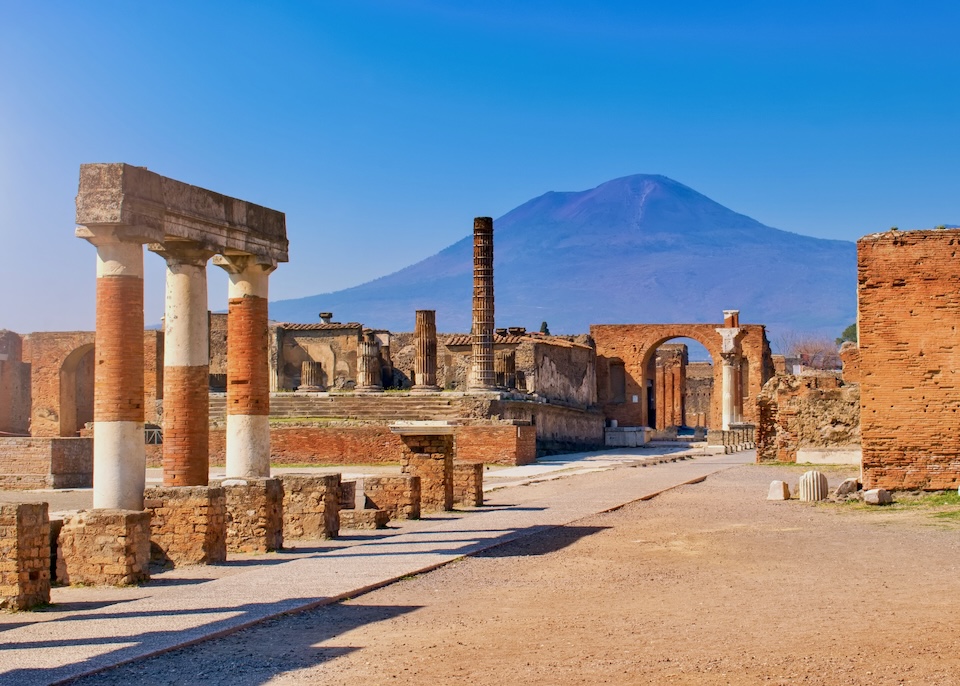
Ancient Pompeii with Mount Vesuvius in the background. The Circumvesuviana train connects Naples and Pompeii in just 30 minutes.
Getting To and Around Naples
Naples is a walkable city, though it is hilly, spread out, busy, and intense. The historic center (Centro Storico) is best explored on foot, but you will need public transport to reach the museums, the Vomero district, and the archaeological sites. The system is robust but can be fragmented between different companies.
- Napoli Centrale & The Metro: Napoli Centrale is the main transit hub. Located beneath it (at the Garibaldi stop) is Metro Line 1, the most useful route for tourists. It connects the train station to the Historic Center (Duomo, Dante), the Archaeological Museum (Museo), and the shopping district (Toledo). Tip: You can now use “Tap & Go” contactless payment with your credit card or phone (Apple & Google Pay) at the turnstiles for the Metro and the Funiculars.
- Buses & Alibus: Buses and trams operated by ANM are the most efficient way to affordably get around inside the city center where the metro and trains don’t reach. Buses run by Alibus serve the airport with pickups and dropoffs at Garibaldi Station and at the ferry port (Molo Beverello).
- Ferries: Naples’ port is one of the largest in Europe. Ferries here connect the city to Sorrento, Amalfi, Positano, Capri, Ischia, Sicily, Sardinia, and beyond, while passing through stunning coastal landscapes and islands. For destinations that can be reached by bus, train, or ferry, opt for the ferry ride to instantly elevate your day trip experience.
- Pompeii, Herculaneum & Sorrento (Circumvesuviana): To reach these sites, use the Circumvesuviana, an older regional train line located on the lower level of Garibaldi Station. It is the cheapest and most direct way to get to Ercolano Scavi (Herculaneum), Pompei Scavi (Pompeii), and Sorrento.
- Funiculars: Because Naples is built on a steep slope, the Funiculars (incline railways) are essential. The Funicolare Centrale connects the shopping street Via Toledo with the Vomero district (for Castel Sant’Elmo) in minutes.
Day Trip Logistics:
- Mt. Vesuvius: Take the Circumvesuviana to the Ercolano Scavi stop, then catch the Vesuvio Express tourist shuttle to the crater entrance.
- The Amalfi Coast: You cannot take a train directly to Positano or Amalfi. The best option is the ferry directly from Naples. Alternatively, take the Circumvesuviana to Sorrento, then transfer to a bus or ferry.
Outside the main entrance of Napoli Centrale, the city’s main train station. Trains from here connect Naples to Rome, Pompeii, Sorrento, Salerno, and Vietri sul Mare on the Amalfi Coast.
Best Places to Stay in Naples
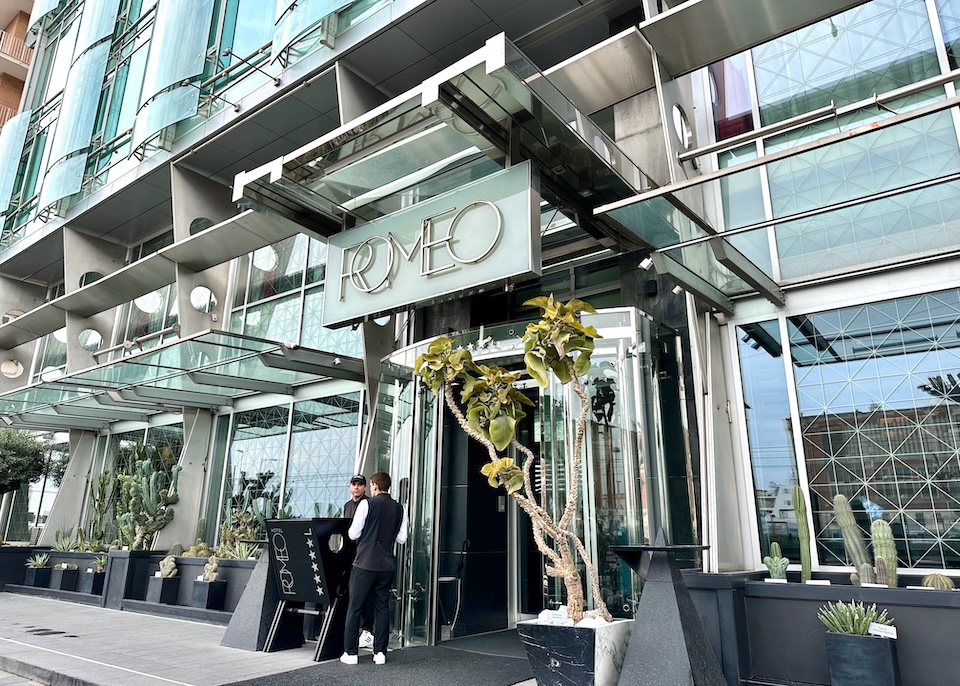
Outside the sleek, luxury hotel Romeo Napoli, a contemporary alternative to the more traditional, sometimes stodgy luxury offerings of the city.
- Best Luxury Hotels in Naples:
De Bonart • Romeo • Grand Vesuvio- Best Hotels for Families in Naples: Grand Vesuvio • Royal Continental • Piazza Bellinil
- Best Hotels for Couples in Naples:
De Bonart • Romeo • Santa Chiara- Best Boutique Hotels in Naples: Santa Chiara • Artemisia Domus • SuperOtium
- Best Midrange Hotel in Naples: SuperOtium
- Best Cheap Hotel in Naples: Il Convento
Best Places in Naples for…
- Where to Stay in Naples for First-Timers: Centro Storico
The Historic Center is the optimal choice for first-time visitors to Naples. This vibrant area offers a genuine taste of the city’s character with its narrow, cobblestone streets, monumental church complexes, and bustling markets. Hotels here run the gamut from luxury to budget, but all are within steps of major landmarks. Highlights include the Duomo (a medieval cathedral filled with art and relics), the vibrant Spaccanapoli (a notable street lined with historic churches and buildings), and Chiesa del Gesù Nuovo (15th-century church with a pyramid studded façade). High quality pizzerias and family-run trattorias are spread throughout the neighborhood, along with several restaurants serving international fare. Not too far away are the port and train station, making it a snap to take day trips by sea or by rail.- Where to Stay in Naples for Sightseeing: Centro Storico and San Ferdinando
For sightseeing, the best spot in Naples is Centro Storico. The entire neighborhood is a UNESCO World Heritage Site, jam packed with medieval and Renaissance churches, museums of classical and contemporary art, a handful of ancient ruins, and even a castle. Aside from the Duomo, Gesù Nuovo, and Spaccanpoli, other not-to-be missed sites include the Veiled Christ and Il Disinganno sculptures in Cappella Sansevero and Caravaggio’s masterpiece Seven Works of Mercy at the church of Pio Monte della Misericordia. Just a few steps over the border of Centro Storico into Rione Sanità is the National Archaeological Museum. Most of the Centro Storico is pedestrian-only, but there are metro stations and bus stops on the roads comprising its borders, making it simple and efficient from here to visit farther-flung city attractions, like Castel Sant’Elmo in Vomero, the Catacombs of San Gennaro or San Gaudiosi in Rione Sanità, or the Royal district and waterfront of San Ferdinando. San Ferdinando is a close second for sightseeing, home to the Royal Palace and adjacent Piazza del Plebiscito, along with the San Carlo Theater (from 1737, the oldest continually active opera house in the world) and Galleria Umberto I (an opulent glass-domed shopping gallery from 1890). From either area, Napoli Centrale and the ferry port are not too far away, so visiting the Amalfi Coast, Sorrento, Capri, or Pompeii is easy to do with Centro Storico as your home base.- Where to Stay in Naples for Couples or Honeymooners: Chiaia
Chiaia is the most enchanting neighborhood in Naples and the city’s premier spot for a romantic getaway. This exclusive area sits along the picturesque waterfront with tree-lined streets, elegant architecture, and stunning views of the Bay of Naples and Mount Vesuvius. Within the city, Chiaia is a destination for its upscale shopping, fine dining, and chic cafes along the fashionable Via dei Mille. The Lungomare seafront promenade runs the entire length of the Chiaia neighborhood and is perfect for late afternoons strolls; the esplanade ends at the Castel dell’Ovo in San Fernandino, a popular spot to take in the sunset before heading to one of the many waterfront restaurants for an intimate dinner.View from Belvedere di Sant’Antonio a Posillipo over the Chiaia neighborhood on the waterfront with Castel dell’Ovo and Mount Vesuvius in the distance.
- Where to Stay in Naples for Families: Vomero
Known for its residential charm, iconic Sant’Elmo castle, and an inviting atmosphere, Vomero is the best pick for a family vacation in Naples. Villa Floridiana is a popular green space known for its lush gardens, playground, and viewpoint overlooking the sea. Away from the crowds of the city center, this tranquil neighborhood provides a relaxed environment with plenty of kid-friendly cafes and parks. Though perched on the hilltop, Vomero is well-connected via public transportation (including the funicular), ensuring that families can conveniently explore.- Where to Stay in Naples for Nightlife: Centro Storico and Vomero
Naples is a fun city with a little nightlife scattered throughout. But you’ll find the highest concentration of bars, clubs, and pubs in Centro Storico around Spaccanapoli, Piazza Bellini, and on its western edge in and near the Spanish Quarter. Visitors will find an array of trendy cocktail lounges, enotecas (wine bars), live music venues, casual pizzerias, and fine dining restaurants packed close together within pleasant walking distance. The busy, narrow streets and mix of historic buildings from different eras add to the festive atmosphere. A close second, Vomero has a slightly smaller nightlife scene than Centor Storico, but what they offer tends to be more sophisticated and laid back. Vomero’s stylish bars and rooftop lounges provide a more relaxed setting for socializing, while taking in panoramic views over the city toward the sea. Visitors can enjoy an array of upscale restaurants offering both local and international cuisines in an intimate, refined setting.- Where to Stay in Naples for Living Like a Local: Spanish Quarters
The Spanish Quarters is the most centrally-located neighborhood that still offers an authentic slice of life, despite its proximity to Naples’ most visited attractions. Here you’ll find the Old Italy that many imagine: a warren of skinny, cobblestone streets with colorful flags, pennant strings, and drying laundry hanging from the balconies and criss-crossing the lanes. Pizzerias, cafes, and open-air markets like the storied Pignasecca abound, all catering to local tastes. There are a handful of historic churches, attractions, and murals worth visiting, but they are mostly lesser known by international travelers and so avoid the worst of the crowds.The Spanish Quarters of Naples with decorated balconies, cobbled streets, and the ubiquitous drying laundry.
The Best Neighborhoods in Naples for Tourists
1. Centro Storico
For most travelers, Centro Storico is the best place to stay in Naples. This vibrant neighborhood is the oldest part of the city, as clearly seen in its extensive architectural heritage. Churches and palaces in Gothic, Baroque, and Rococo styles are packed tightly along streets more than two thousand years old. The most important of these is the Duomo (Naples’ cathedral), which safeguards the relics of San Gennaro. On the west side of the neighborhood, the Piazza del Gesù Nuovo is bordered by the imposing Gesù Nuovo Church, whose façade of stony, diamond-shaped projections looks like armor, and the ornate Church of Santa Chiara, known for it’s maiolica-tiled cloister, depicting in vivid colors scenes from mythology, the countryside, and maritime life. Church-turned-museum, Cappella Sansevero, houses intricate frescoes and sculptures, most notably the masterpieces of the Veiled Christ (known for its extraordinary realism, where the veil cut from the marble appears translucent) and Il Disinganno (“Disillusion,” depicting a man being released by an angel from an impossibly intricate net ).
Much of the neighborhood’s activity is clustered on or nearby the notable streets of the Spaccanapoli (officially named Via Benedetto Croce), Via dei Tribunali, and Via Toledo. Spaccanapoli “splits” the city center and is known for its It’s famous for its bustling atmosphere, lined with shops, cafes, and quintessential landmarks. Via dei Tribunali runs parallel to Spaccanapoli and serves as a cultural hub, lined with traditional pizzerias and historic buildings. Via Toledo makes up the border between Centro Storico and the Spanish Quarters. This major commercial street is filled with shops and cafes. Walking south along Via Toledo leads to the San Ferdinando neighborhood’s Royal district, where you’ll find Galleria Umberto I and the Royal Palace. Smaller than these streets but infinitely charming is Via San Gregorio Armeno, better known as Christmas Alley, famed for its artisan workshops making Nativity scenes, along with figurines of contemporary celebrities and cornicelli, the little red horns that look like chili peppers, said to protect against bad luck and the evil eye. Beneath all these streets is Napoli Sotterranea (Naples Underground – a vast network of ancient tunnels and catacombs), an incredible spot to escape the heat of the day while learning a little of the city’s past, available to visit only with a guided tour.
- Best Luxury Hotel in Centro Storico
MGallery Palazzo Caracciolo • Hotel phone: +39 081 016 0111- Best Boutique Hotels
Santa Chiara • Hotel phone: +39 081 522 7077
Artemisia Domus • Hotel phone: +39 081 304 6280
Piazza Bellini • Hotel phone: +39 081 451 732- Best Budget Hotel
B&B I Maestri • Hotel phone: +39 392 629 69382. Chiaia
On the waterfront about 2km west of Centro Storico, Chiaia is celebrated for its upscale ambiance with a mix of cultural, historical, and modern elements. Travelers here will find elegant streets lined with high-end shops, boutiques, and art galleries along with a hot culinary scene that stacks sophisticated restaurants alongside traditional Neapolitan pizzerias, most famously Pizzeria Brandi – birthplace of the Margherita pizza. Architecturally, Chiaia shines with historic buildings and well-preserved palaces, like the neoclassical Villa Pignatelli, former home to Italian royalty until the mid-twentieth century.
Along the coastline, the Lungomare promenade offers stunning views of the Gulf of Naples and Mount Vesuvius – perfect for sunset strolls. Just behind the Lungomare, Villa Comunale park provides a tranquil escape with lush greenery. Inside the park, the Acquario di Napoli is the oldest public aquarium in Italy. A small, rocky beach fronts the park (though there are better beaches southwest in Posillipo; try Monache or Gaiola).
- Best Luxury Hotels in Chiaia
De Bonart • Hotel phone: +39 081 090 2000
Grand Parker’s • Hotel phone: +39 081 761 2474- Best Boutique Hotel
Palazzo Albardieri • Hotel phone: +39 081 415 278- Best Budget Hotel
La Dimora Di Nettuno • Hotel phone: +39 081 761 63723. San Ferdinando
San Ferdinando is almost tied with the Centro Storico for the most important landmarks. Instead of the skinny medieval lanes and Renaissance architecture, San Ferdinando has grand piazzas and Neoclassical construction. This neighborhood includes the Royal district, so named for being the home of the stately Palazzo Reale (Royal Palace), which is attached to the opera house, Teatro di San Carlo. Directly across from the palazzo is the magnificent Piazza del Plebiscito, a focal point of Neapolitan life. The square is anchored by the Basilica of San Francesco di Paola, inspired by Rome’s Pantheon, with a 53-meter-tall, coffered dome and elegant columned portico. The district is also home to the Galleria Umberto I, a stunning example of 19th-century iron and glass construction. The streets of San Ferdinando, such as the fashionable Via Chiaia and the elegant Via Toledo, are lined with a mix of high-end boutiques, traditional shops, and quaint cafes, offering a delightful blend of shopping and leisure experiences.
Moving south toward the waterfront, there are two castles in San Ferdinando: Castel Nuovo (New Castle, also called Maschio Angioino) and Castel dell’Ovo (Castle of the Egg). An imposing medieval fortress with round towers and heavy stone walls, Castel Nuovo sits to the east, almost in the Port district. Castel dell’ Ovo, Naples’ oldest castle, sits on an islet in the Santa Lucia district of San Ferdinando. One anachronistic legend holds that the poet Virgil hid a magic egg in the castle’s foundation. If the egg breaks, both the castle and the city will be destroyed. Known for its quiet lanes and waterfront views, Santa Lucia offers a more tranquil and scenic experience than the rest of San Ferdinando. The district’s streets, brimming with local eateries and artisanal shops, lead to a waterfront promenade with views of the Bay of Naples and Mount Vesuvius.
- Best Luxury Hotels in San Ferdinando
Grand Vesuvio • Hotel phone: +39 081 764 0044
Grand Santa Lucia • Hotel phone: +39 081 764 0666
Royal Continental • Hotel phone: +39 081 245 2068- Best Boutique Hotel
La Ciliegnia • Hotel phone: +39 081 764 0044- Best Budget Hotel
Daily Napoli • Hotel phone: +39 081 245 74944. Vomero
Hilltop Vomero is an affluent neighborhood, home to several historic landmarks, wonderful dining and shopping, and a little nightlife. Travelers here will find wide, tree-lined streets and plenty of green spaces and parks, like the Villa Floridiana, a neoclassical home whose expansive gardens are now a public park. Via Luca Giordano and Via Alessandro Scarlatti are favorite streets for shopping and dining with a range of high-end boutiques and traditional Neapolitan shops: tailors, cobblers, wine shops, bookstores, and more. The star-shaped, medieval fortress Castel Sant’Elmo is here along with the Certosa di San Martino, a former monastery now housing a museum. Both offer stunning views over the city to the sea.
Dining in Vomero runs the gamut from gourmet restaurants to traditional pizzerias and casual trattorias serving local specialties. Visit Mercato di Antignano, a vibrant street market offering fresh produce, street food, and Neapolitan delicacies, along with clothing, shoes, and jewelry.
- Best Luxury Hotel in Vomero
San Francesco al Monte • Hotel phone: +39 081 423 9111- Best Boutique Hotel
La Casina Rossa • Hotel phone: +39 339 630 5200- Best Budget Hotel
Villa San Martino • Hotel phone: +39 081 1894 92475. Spanish Quarters
The Spanish Quarters (Quartieri Spagnoli), built in the 16th century to house the Spanish garrisons, is a lively and densely populated district in the heart of the city. Its grid-like street layout reflects its original military purpose. It is separated from Centro Storico by the bustling, commercial street Via Toledo, while also encompassing parts of San Ferdinando to the south and Montecalvario to the north. Historic landmarks in this area include the Church of Santa Maria Francesca delle Cinque Piaghe. This Baroque church houses the relics of the city’s only female saint, a stigmatic whose blessing is believed to grant fertility and safe childbirth.
The most centrally located “locals” enclave, the atmosphere in the Spanish Quarters is distinctly Neapolitan: cobbled alleys, clothes hanging out to dry, and murals dedicated to soccer legend, Diego Maradona. The streets are lined with small shops, traditional artisan workshops, and family-owned trattorias. Many pizzerias here serve up the city’s beloved pizza fritta (fried pizza) – a recipe born after WWII bombings destroyed most of the city’s wood-fired ovens. Visit Mercato della Pignasecca, an open-air market in Montecalvario to try a cuoppo (a paper cone filled with mixed fried seafood and vegetables), while people-watching and shopping the colorful produce, crafts, and souvenirs from the stalls.
- Best Boutique Hotel in the Spanish Quarters
NapoliMia • Hotel phone: +39 081 1991 2326- Best Budget Hotel
In Convento • Hotel phone: +39 373 751 82776. Porto
Porto is the waterfront district fronting Naples’ port. The port was the most bombed spot in the most bombed city in WWII. Even before that, an urban renewal project begun in the late 1800s, the risanamento, tore down many older buildings near the waterfront (including Castello del Carmine) along with the slums and overcrowded streets to make way for more modern transportation and stately buildings like the University of Naples. As such, you’ll find today several sleek, contemporary buildings (even one skyscraper, shown above) mixed in with medieval and neoclassical architecture.
Porto begins in Piazza Municipio immediately northeast of Castel Nuevo and continues eastward around the bend just past the ruins of Castello del Carmine. It is separated from the Centro Storico by the streets Corso Umberto I and Via Bartolomeo Capasso. Many restaurants here offer fresh seafood and Campanian dishes, many with sea views, and a handful serving international fare. Bars and nightclubs tend to be located on the northern edge, near the University. The main appeal of this area is the convenience it offers travelers. It’s easy to walk to the sights, shopping, and dining of Centro Storico and San Ferdinando, as well as ferry to the nearby islands of Capri and Ischia, and the port towns (like Positano) along the Amalfi and Sorrentine Coasts.
- Best Luxury Hotel in Porto
Romeo Napoli • Hotel phone: +39 081 604 1580- Best Boutique Hotel
Amadomus Luxury Suites • Hotel phone: +39 081 1902 2339- Best Budget Hotel
Villa San Martino • Hotel phone: +39 081 1894 92477. Rione Sanità
Just north of Centro Storico but still off-the-radar for most travelers, Rione Sanità is an authentic, Neapolitan slice of life with colorful, crooked streets (seriously – watch your step), a bustling outdoor market (Mercato dei Vergini), and casual trattorias, pizzerias, and bars. But the neighborhood is most famous for its catacombs. The area served as a burial ground for ancient Greeks and Romans. Most notably the Catacombs of San Gennaro and San Gaudioso are major attractions with daily tours that provide a fascinating glimpse into Paleochristian burial practices. The Basilica of Santa Maria della Sanità sits on top of the San Gaudioso catacombs, known for its distinctive gold and green dome. The 16th-century Fontanelle Cemetery is set in a vast cave system, part natural and part hand-dug, and includes an ossuary reminiscent of the Paris Catacombs.
The neighborhood later evolved into a retreat for noble families, who commissioned the building of grand villas and palaces. Palazzo Sanfelice and Palazzo dello Spagnolo are the most iconic of these Baroque landmarks, both designed by the same architect in the early 18th century and known for their “hawk wing” double staircases. The following centuries were not kind to Rione Sanità, due in part to overcrowding, poor infrastructure, and mafia activity. But recent rejuvenation efforts have restored many of its historic sites and transformed it into a hub for arts and culture. The National Archaeological Museum is here with Greek, Roman, and Egyptian antiquities, along with a collection of erotica from ancient Pompeii and Herculaneum.
- Best Luxury Hotel in Rione Sanità
Villa Elisio • Hotel phone: +39 081 1819 3835- Best Boutique Hotel
SuperOtium • Hotel phone: +39 081 1902 2339- Best Budget Hotel
B&B Tarumbó • Hotel phone: +39 348 865 76338. Napoli Centrale
Near Napoli Centrale train station, the neighborhoods of Porta Nolana (immediately south of the station), Centro Direzionale (CDN), and Vasto (both north of the station) offer distinct experiences with convenient transit for day trips. Porta Nolana, with its historic gate and lively fish market, captures the traditional Neapolitan spirit with its vibrant atmosphere and local street food. Vasto, blending historical charm with modern elements, features narrow alleys, varied architecture from several eras, and an array of shops and casual dining. In contrast, Centro Direzionale is a contemporary business district, marked by modern architecture and high-rises. Completed in 1995, the CDN is home to the first skyscrapers in Italy and in Southern Europe. The entire area was designed by famed Japanese architect Kenzo Tange, who also designed Romeo Napoli in the Porto district.
Other than the ancient gates to city, there are few attractions within the boundaries of these neighborhoods. Porta Nolana and Vasto are both a short walk from Centro Storico, making it a breeze to reach the city’s best-loved sights. The sleek CDN is about half an hour from the Duomo on foot but is well-connected to the city’s landmarks via bus and metro. The main draw for travelers staying in any of these neighborhoods is the proximity to the train and metro stations. Napoli Centrale is the region’s main train station with connections to all major Italian cities and broader Europe. Garibaldi metro station is downstairs from Napoli Centrale with intra-city routes linking the city’s varied neighborhoods and attractions. The Circumvesuviana station connects Naples to the archaeological sites Pompeii and Herculaneum, Mount Vesuvius, Sorrento, and the Amalfi Coast.
- Best Luxury Hotel near Napoli Centrale
Starhotels Terminus • Hotel phone: +39 081 779 3111- Best Boutique Hotel
SuperOtium • Hotel phone: +39 081 1902 2339- Best Budget Hotel
Napoli City Rooms • Hotel phone: +39 081 553 5779The 12 Best Hotels in Naples, Italy
1. De Bonart
Hotel phone: +39 081 090 2000
Hilltop hotel in a historic 19th-century building with panoramic views over the city toward the sea. The rooftop is home to an upscale Neapolitan restaurant, craft cocktail lounge, the daily breakfast buffet, and a sun terrace with a seasonal jacuzzi. The wellness center includes a gym and spa, with complimentary access to the steam room, salt room, and hot tub. Most rooms have king-sized beds, walk-in showers, and Juliet balconies; some add sofabeds, terraces, or sea views. Suites are more spacious and include original works by contemporary Neapolitan artists. Located in elegant Chiaia on the border with Vomero, near dining, nightlife, and shopping.2. Romeo Napoli
Hotel phone: +39 081 604 1580
The five-star Romeo Napoli blends Italian style and exuberance with contemporary Japanese architecture and design. Its glass and steel exterior gives onto a sleek interior with sharply designed rooms. The best rooms offer sweeping harbor views; suites add jetted baths. A stocked minibar and daily breakfast is included in all room rates. Its lavish spa is free for hotel guests to enter and features three jacuzzis in different temperatures, a salt room, a Knepp hot/cold wading circuit, hammam, and sauna. There is also a small heated pool with hydrotherapy on the rooftop. On the top floor, find a Michelin-starred, Neapolitan-Mediterranean restaurant whose wine list boasts over 1000 labels. On the ground floor, the lobby bar and cigar bar feature quality cocktails and bites in an gallery space filled with international art from the owner’s own collection. Set in the bustling port district, near the ferry terminal, Castel Nuovo, dining, and nightlife.3. Santa Chiara Boutique Hotel
Hotel phone: +39 081 522 7077
Luxury boutique hotel with a rooftop terrace set in the palazzo of a 17th century count. Its ten rooms and suites are all different in size (22 to 62 square meters) and layout (open plan, multi-room, or mezzanine), but all have walk-in showers and city views; some have private balconies. Spacious suites sleep up to 6 guests. A continental breakfast is available each morning, and bar service is offered every evening. The hotel enjoys a perfect location in the Centro Storico between Sansevero Chapel Museum and the Basilica of Santa Chiara, and just steps to Underground Naples, several museums, shops, restaurants and more.4. Grand Hotel Vesuvio
Hotel phone: +39 081 764 0044
A Naples landmark, this seafront five-star hotel has seen its fair share of A-listers over the years, hosting the likes of Humphrey Bogart, Keanu Reeves, and Bill Clinton. The atmosphere is old-school luxury with uniformed staff and lavish décor – dripping chandeliers, period furniture, polished wood. Up top, a rooftop restaurant and small plunge pool command unforgettable sea views. Indoors, there’s a spa, good-sized swimming pool, sauna, steam room, and jacuzzi. Most rooms and suites have private balconies, some with a view to the sea and the Castel dell’Ovo. In all honesty, the hotel has aged – mostly gracefully but a refurbish would be welcome. Wonderful seafront location in Santa Lucia near the Lungomare, dining, and shops.5. Artemisia Domus
Hotel phone: +39 081 304 6280
Luxury boutique hotel with 4 rooms and 4 suites set in a palace from the mid-1700s. Two rooms have Juliet balconies; one room and the two-bedroom apartment have kitchenettes. All suites double as private spas with in-room jacuzzis, saunas, chromotherapy, and aromatherapy; massage treatments are offered in the suites. Continental breakfast is included in the rates. The lobby lounge is available all day for light fare, aperitivo, and refreshments. Situated on the west end of Centro Storico, near Sant’Anna dei Lombardi and Basilica of Santa Chiara, shopping on Via Toledo, and plenty of dining options.6. Grand Hotel Parker’s
Hotel phone: +39 081 761 2474
This grand, old five-star hotel (in business since 1870) sits in lofty splendor above Naples’ historic center. Marble and crystal abound and its elegantly attired rooms feature high ceilings and gleaming antique furniture. There are inspiring panoramas to be enjoyed from the rooftop bar and restaurant.7. Grand Hotel Santa Lucia
Hotel phone: +39 081 764 0666
Romantic, luxury hotel in a Belle Epoque building. Contemporary rooms feature Juliet balconies, marble bathrooms, and parquet floors, most with sea views. Some suites add sofabeds. An Italian buffet breakfast is available daily. Lunch, dinner, and cocktails are on offer throughout the day at the Neapolitan-international restaurant, Il Pavone, which also houses a stunning, Liberty Style bas relief original to the building. Enviable waterfront location facing Castel dell’Ovo, near the Lungomare, museums, and restaurants.8. SuperOtium
Hotel phone: +39 081 544 2071
Art-forward yet unpretentious boutique hotel with seven character-filled rooms and suites, one of which is often occupied by an artist-in-residence. Devoted to creativity, the hotel hosts exhibitions of contemporary art, collaborations, and talks with local and international artists. The hotel also curates experiences for guests to create their own art and explore hidden and non-traditional locales. Accommodations differ but all include a private bathroom with a walk in shower, floors of vintage maiolica or parquet, and colorful, hand-painted canopies over the beds. Most rooms have a small, private balconies. A vegetarian Italian breakfast is served for free every morning. Located in the up-and-coming Rione Sanitá neighborhood, right next door to the National Archaeological Museum, near the catacombs, botanical garden, and humble trattorias that cater to local tastes.9. La Ciliegina Lifestyle Hotel
Hotel phone: +39 081 1971 8800
This classy boutique hotel is well positioned for the center and the hydrofoil terminal (for day trips to Capri). Its 14 rooms sport a Mediterranean look with tiled floors, white walls, and the odd burst of color. A rooftop terrace comes with a hot tub, sun loungers and views over to Vesuvius. Located in the Royal district of San Ferdinando, near Castel Nuovo, the Royal Palace, San Carlo Theater, and the Galleria Umberto I, known for its casual cafes and shopping in an impossibly opulent setting.10. MGallery Palazzo Caracciolo
Hotel phone: +39 081 016 0111
This history-filled palace-turned-hotel dates to the 16th-century and was the home of the King of Naples (and Napoleon’s brother-in-law), Joachim Murat. The hotel offers a luxury spa, small gym, and a gourmet restaurant in its Renaissance-era cloister. Rooms and suites feature terracotta floors and traditional decor in silver and white. Some rooms have private balconies. Suites and junior suites sleep up to 4 guests on a single floor or loft layout. Wonderful location in Centro Storico near Porta Capuana (the ancient gate of the city), the Gothic church San Giovanni a Carbonara, and the Donnaregina Monumental Complex (one Gothic church, one Baroque church, and the Diocesan Museum).11. Hotel Piazza Bellini
Hotel phone: +39 081 451 732
The boutique Bellini offers a warm welcome, a contemporary look and a prime setting on a fashionable historic center piazza. Housed in a 16th-century palazzo, it’s within walking distance of many of the city’s big sights and has smart rooms furnished in a tasteful minimalist style. One and two bedroom apartments have a small kitchen and are great for groups and families.12. Royal Continental
Hotel phone: +39 081 245 2068
Upscale hotel in a 19th-century building with waterfront views toward Castel dell’Ovo and the marina and a rooftop pool designed by renowned architect, Gio Ponti, in 1954. Theirs is the best pool in Naples with a caveat: to preserve the pool itself, as well as the atmosphere, reservations are required at the pool, there is a per hour usage fee, and swim caps are required. One floor of the hotel features museum rooms and junior suites decorated with vintage furniture also designed by Ponti. Many rooms have private balconies. Dining options have been recently reimagined with a chemistry-themed cocktail and pizza bar, a gourmet Mediterranean restaurant. Breakfast is included in all bookings. Great location on the Lungomare within a short walk of restaurants and attractions, including the fascinating Galleria Borbonica underground tunnel complex.
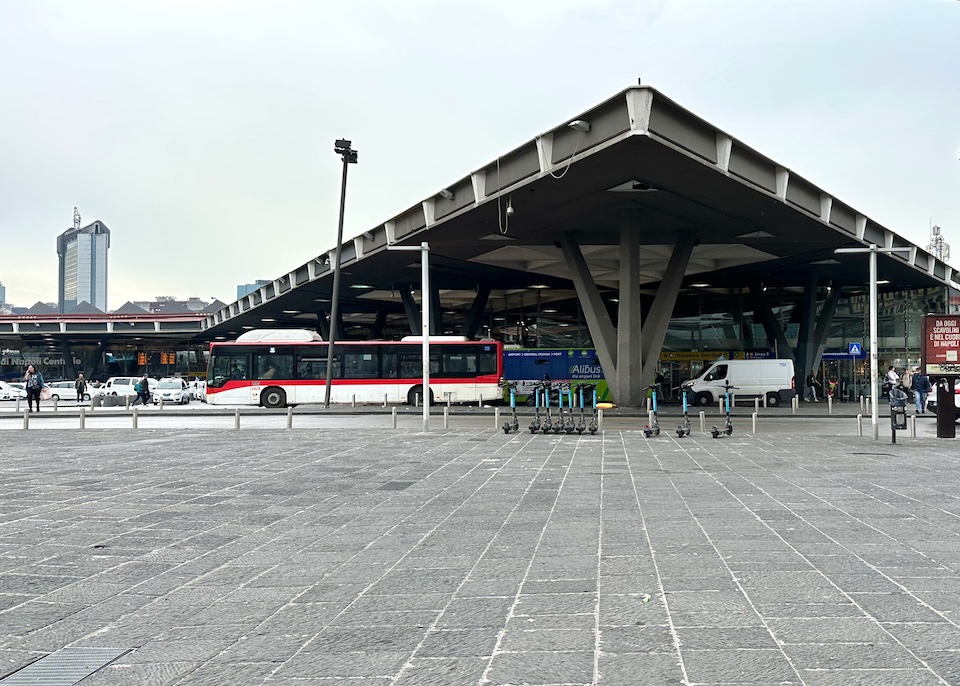
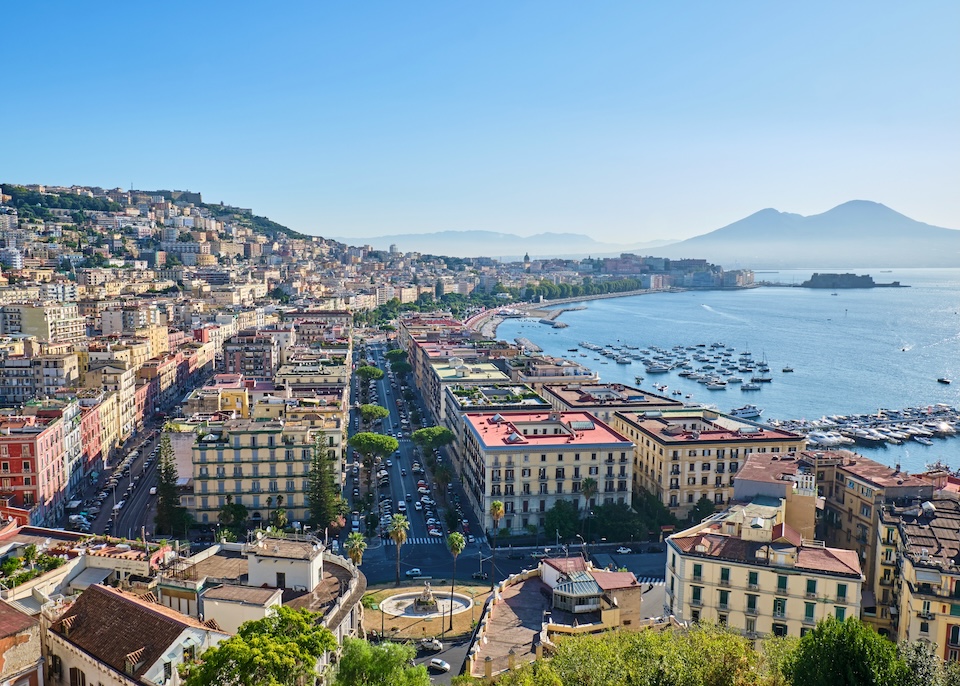
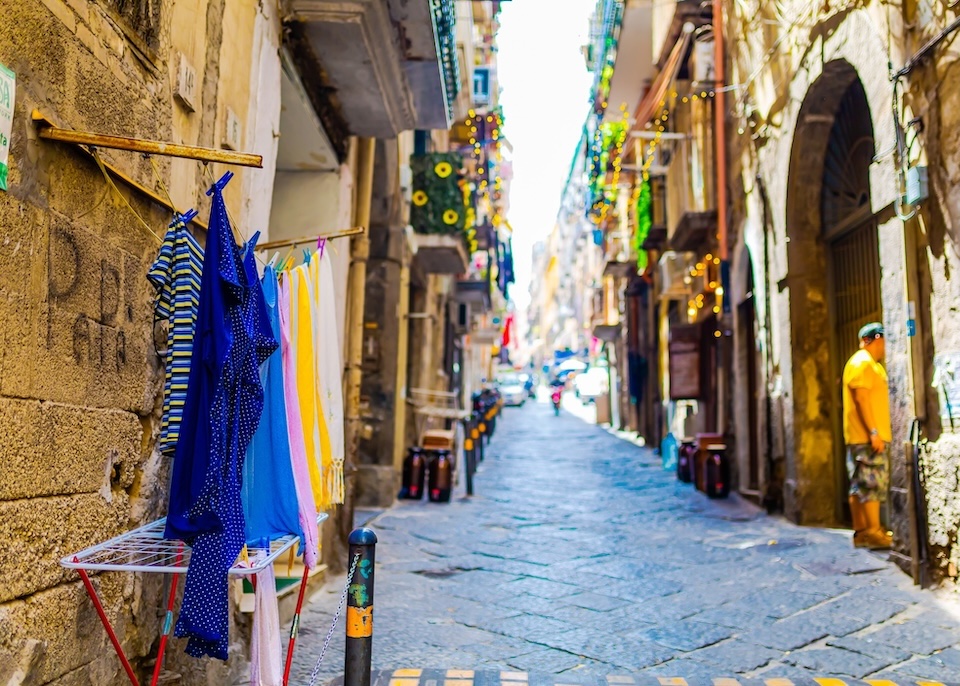
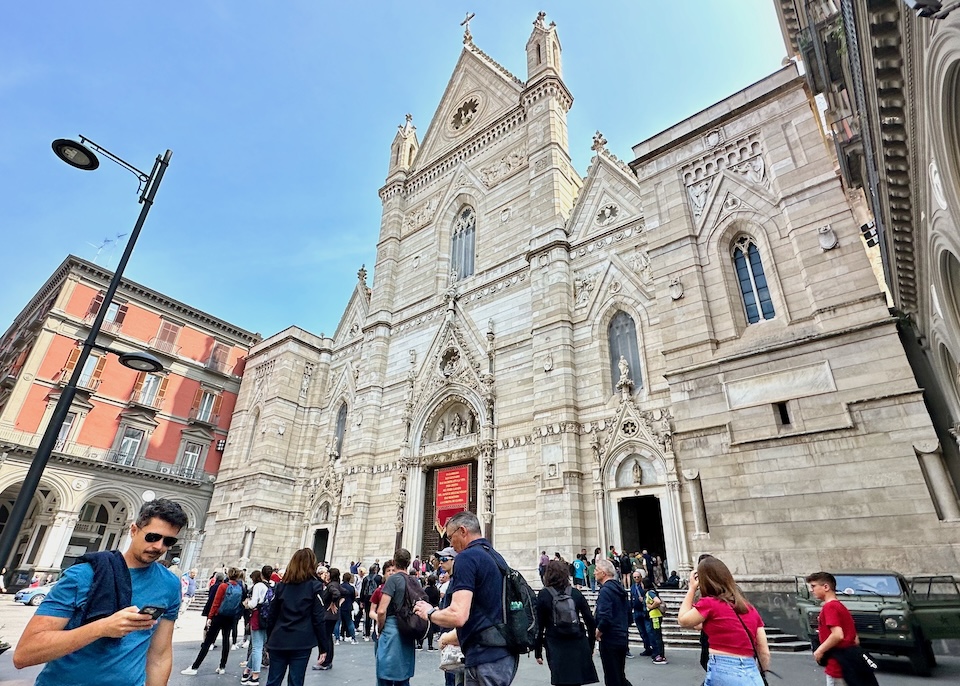
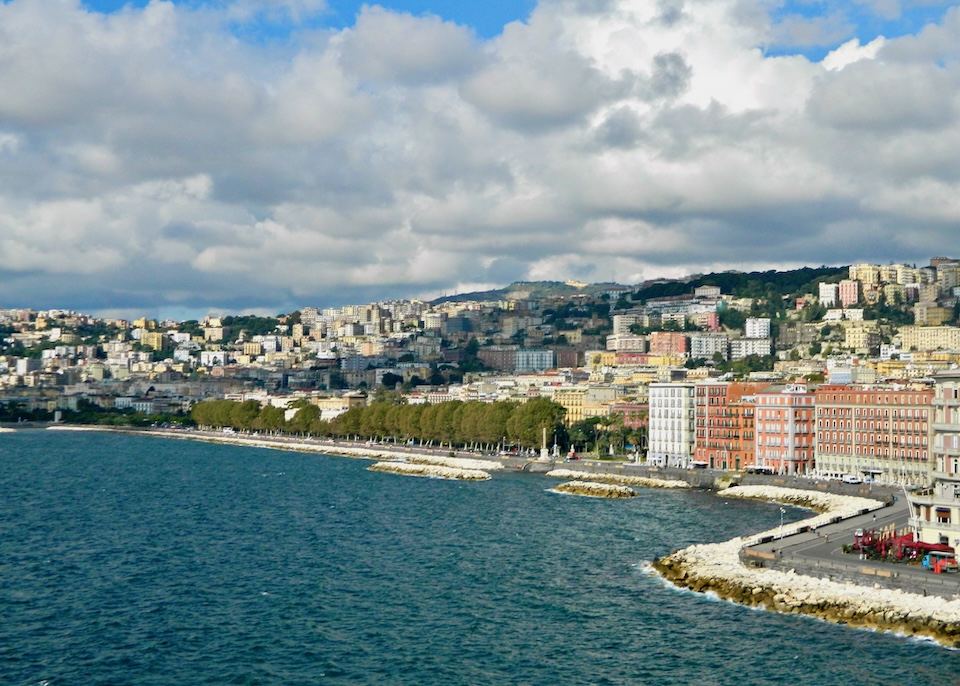
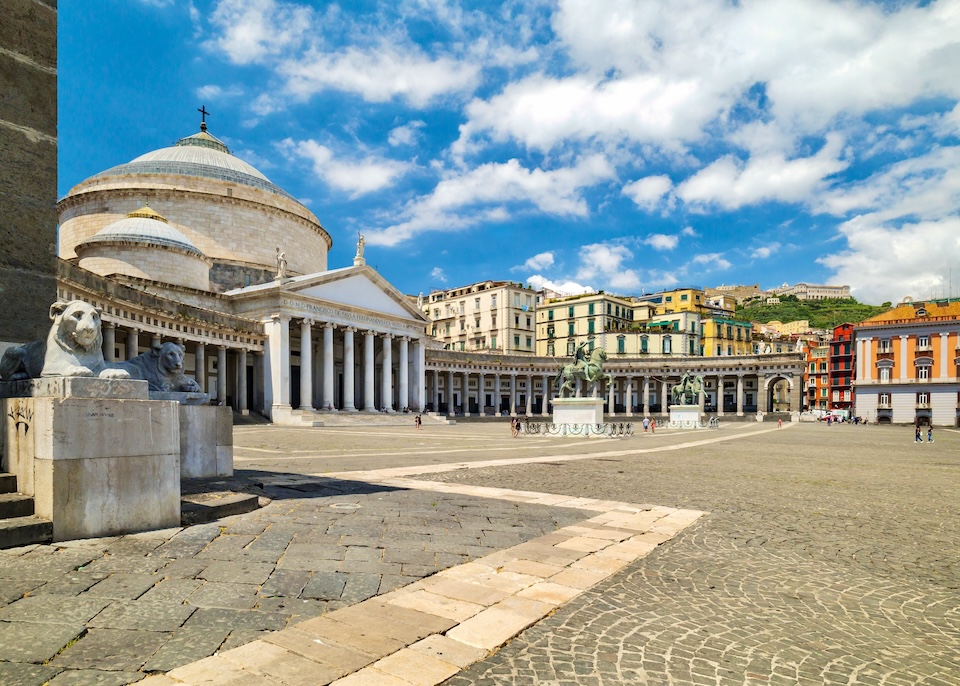
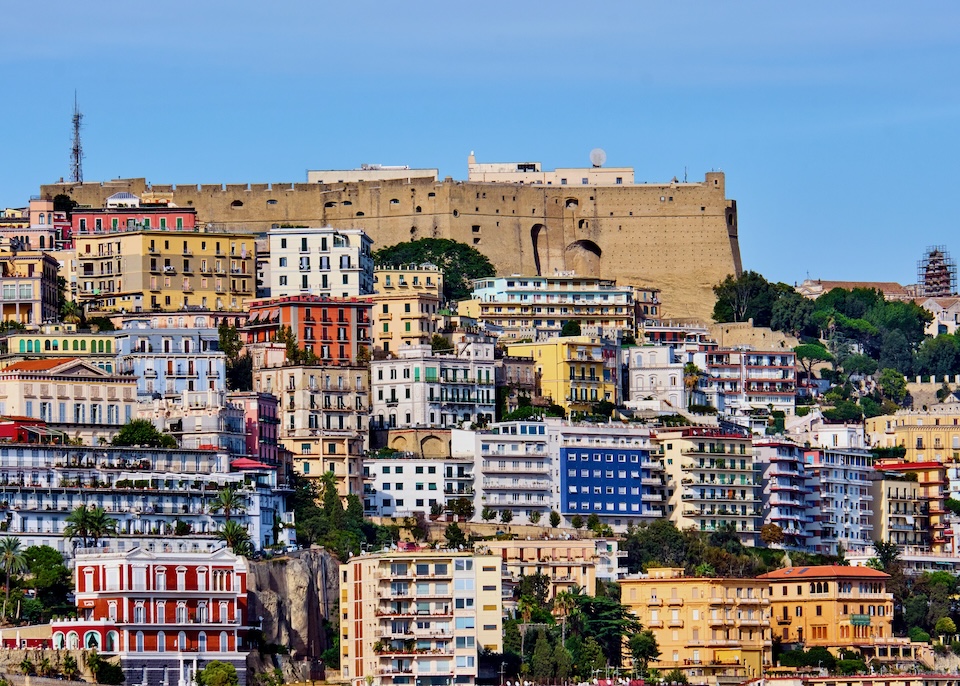
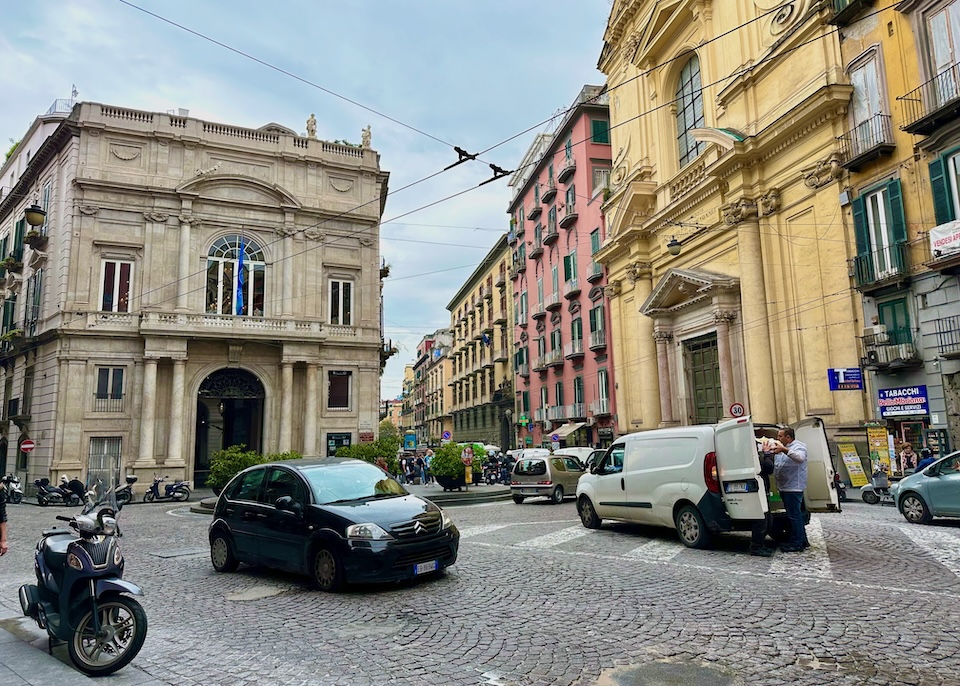
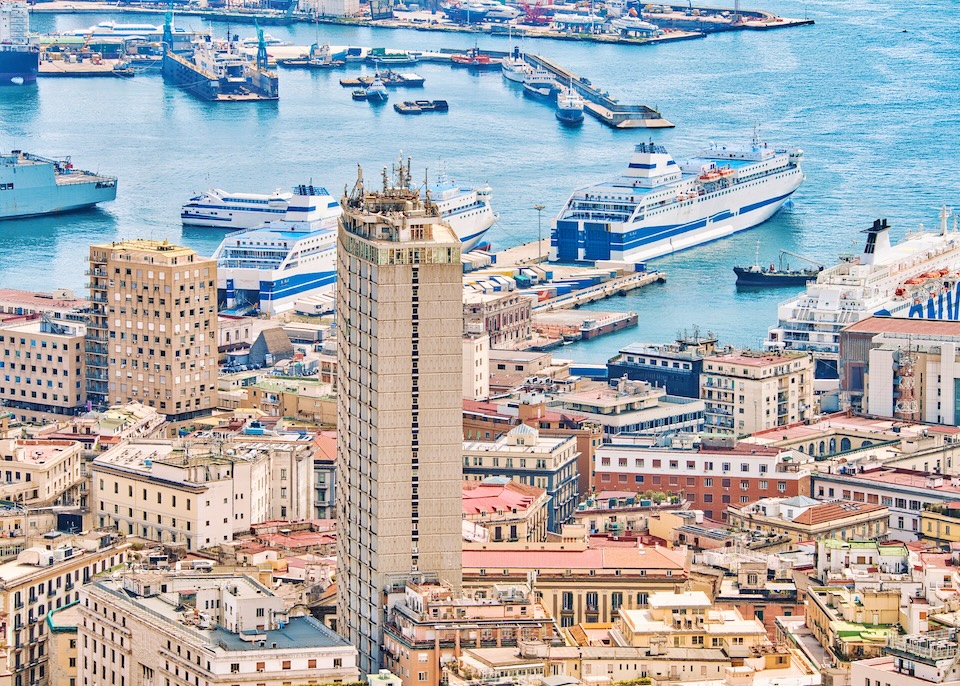
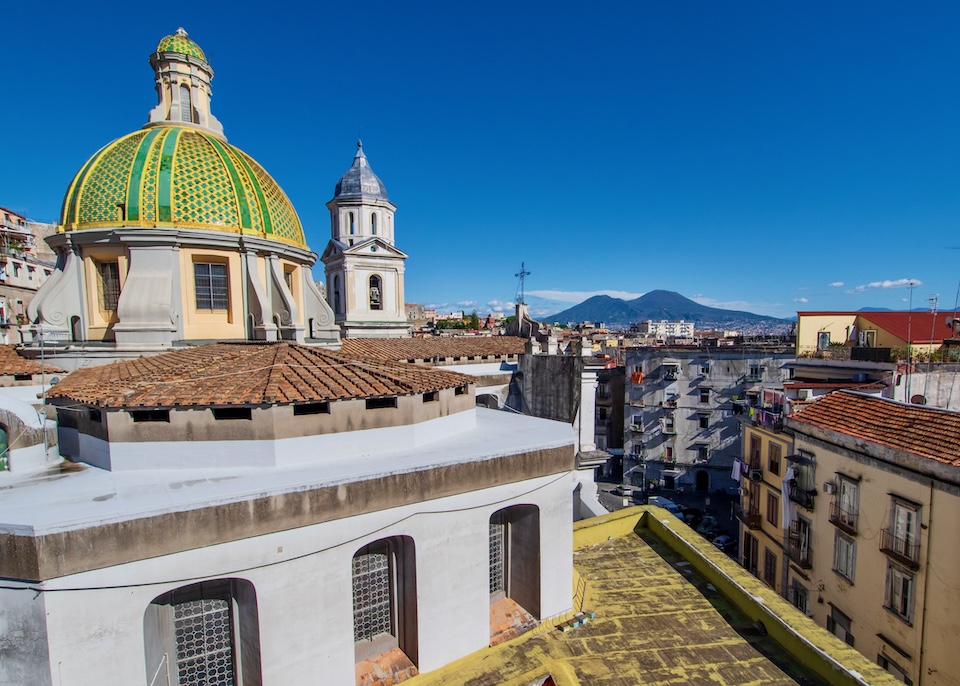
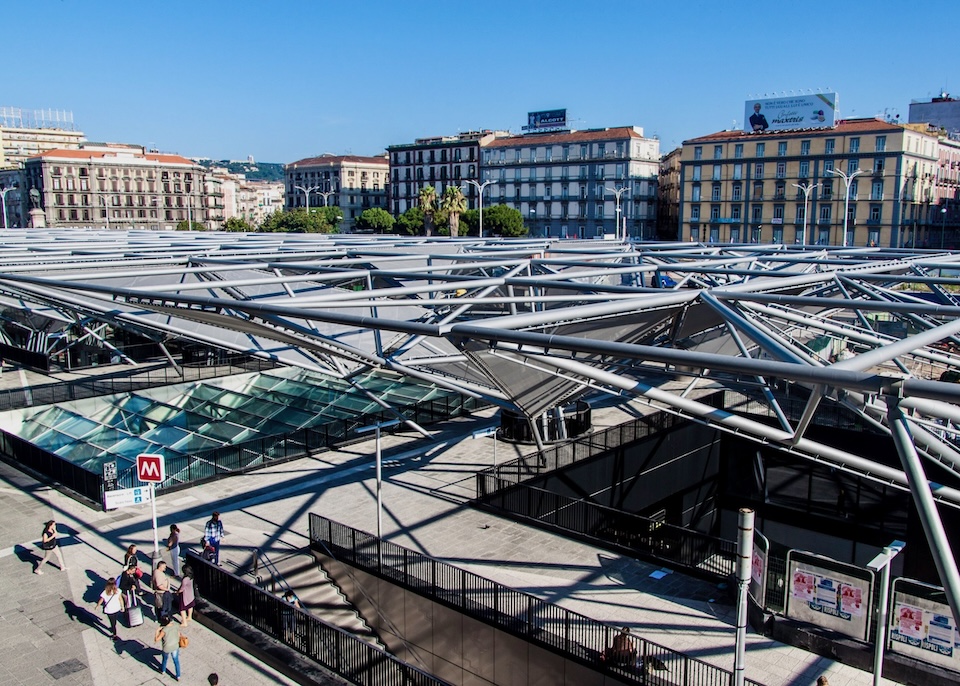
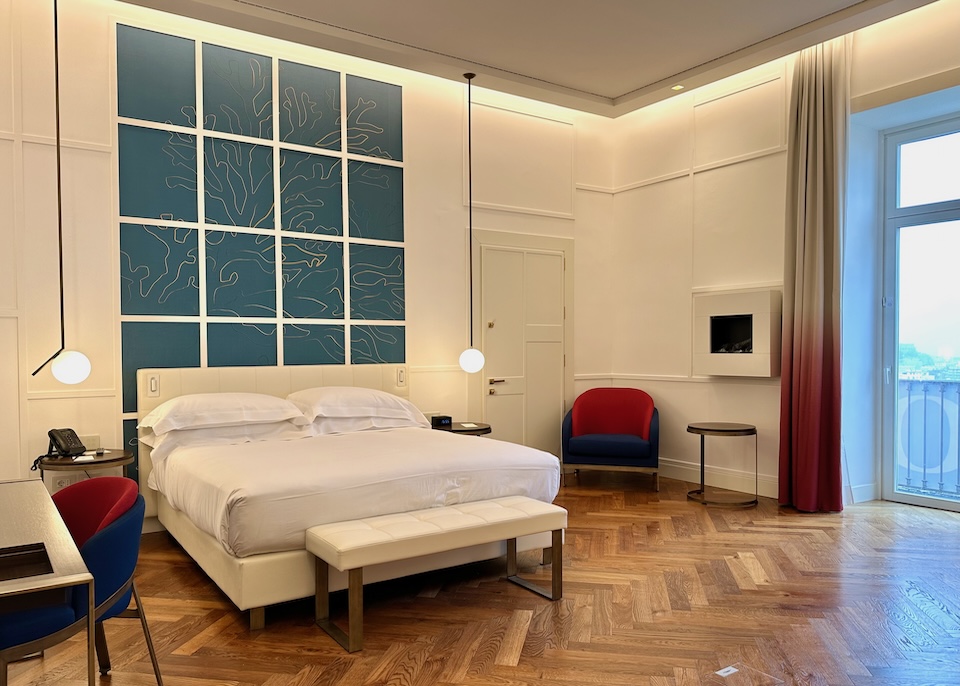
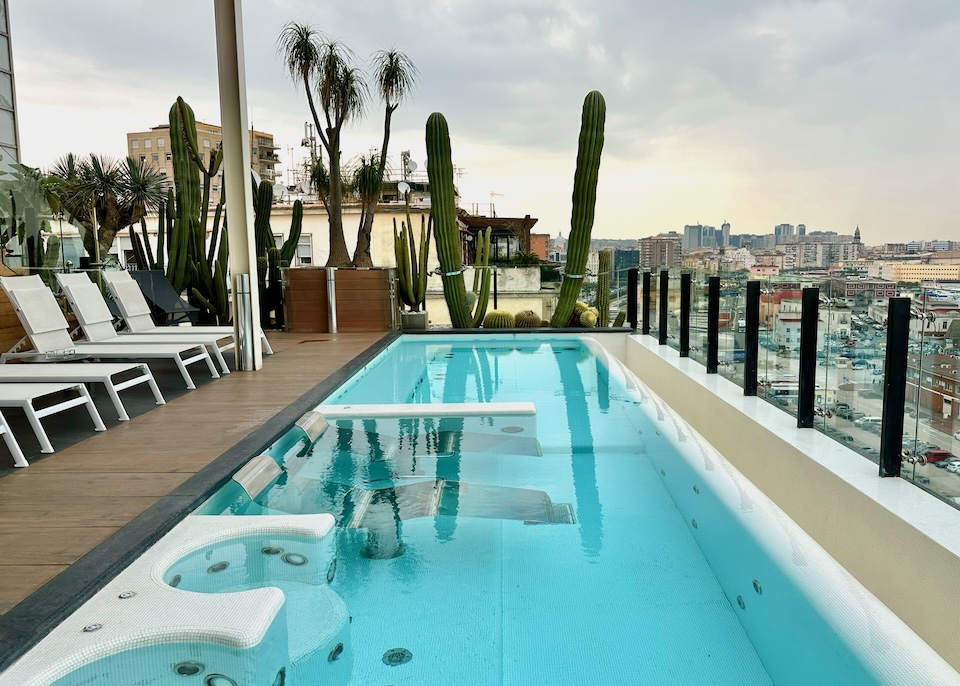
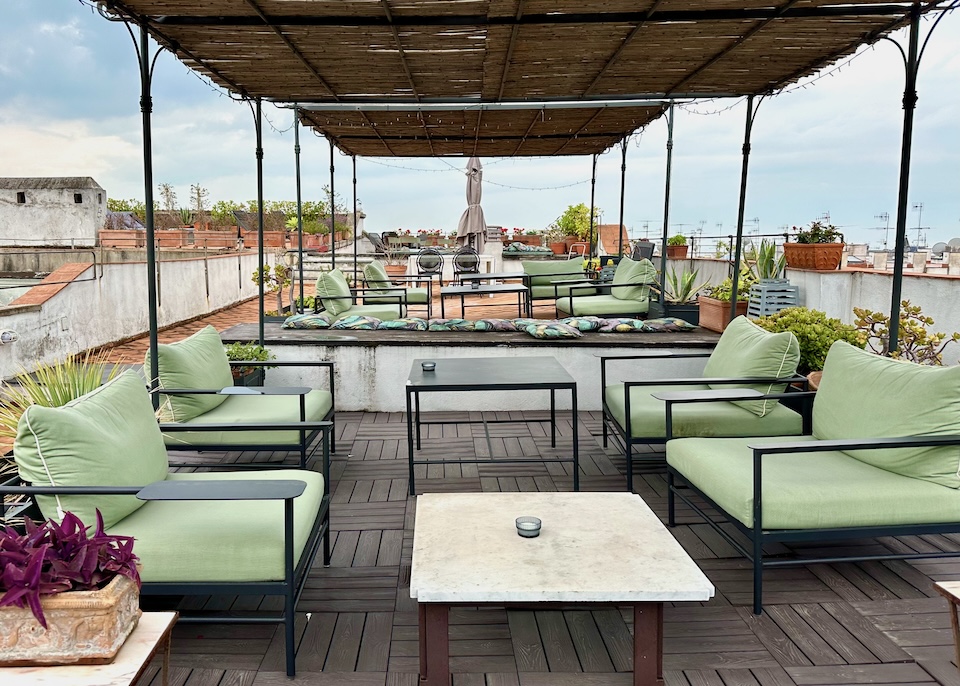
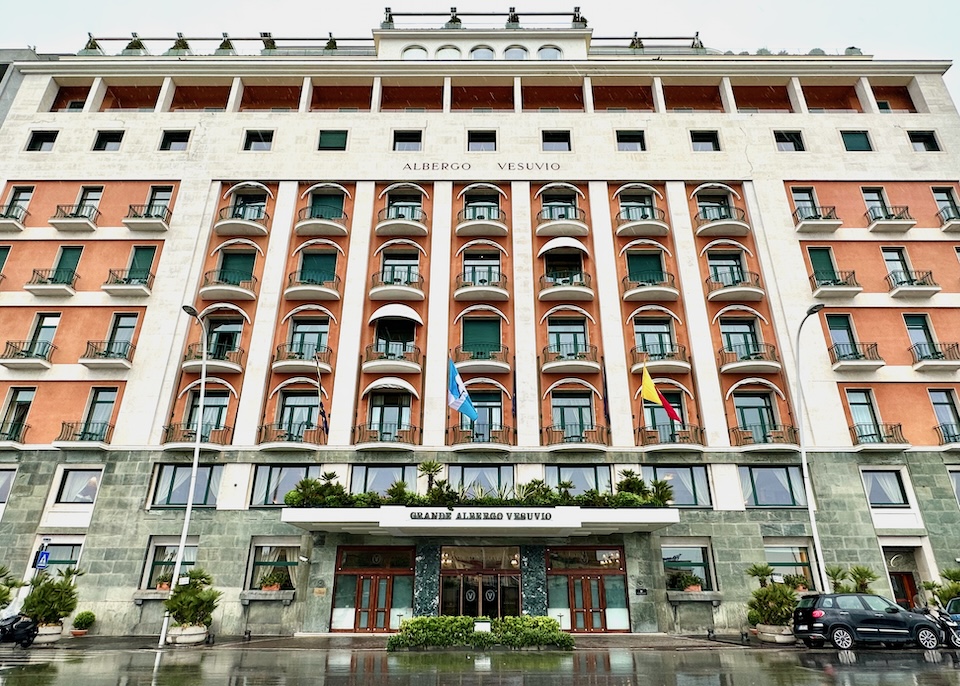
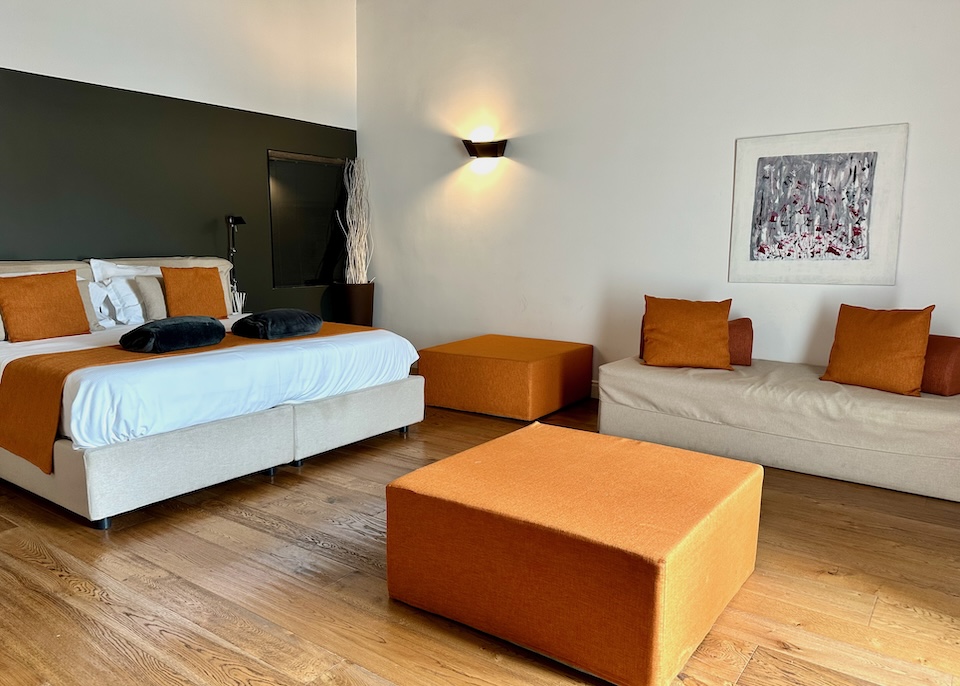
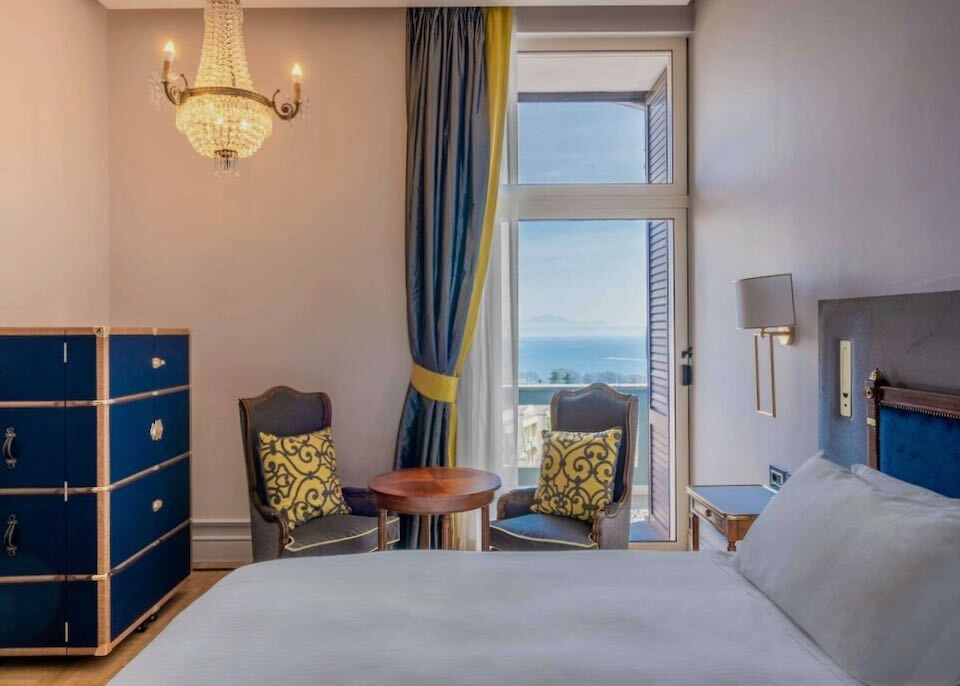
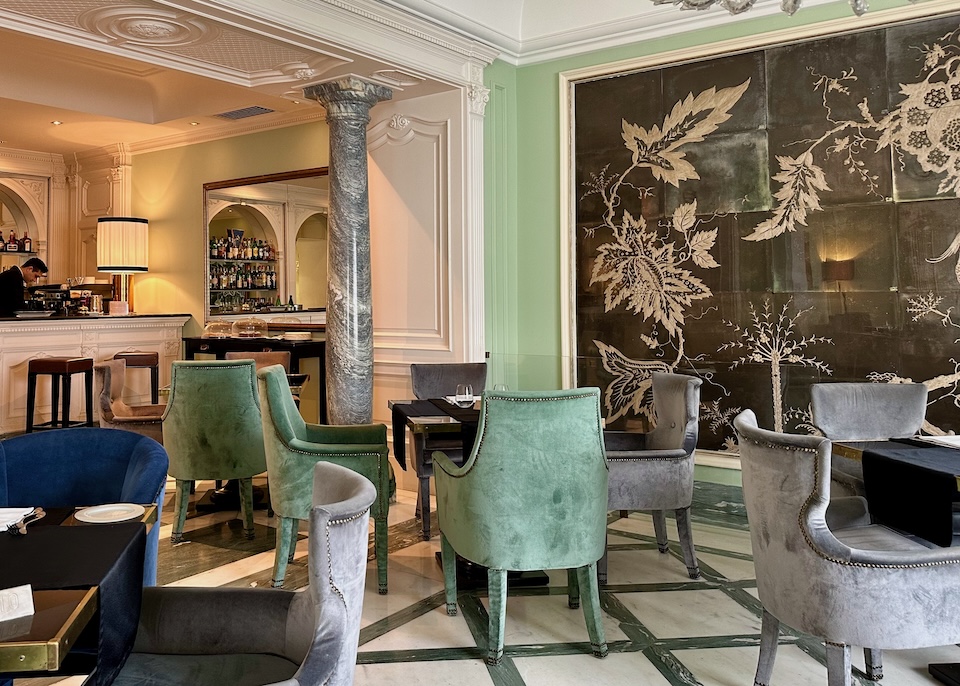
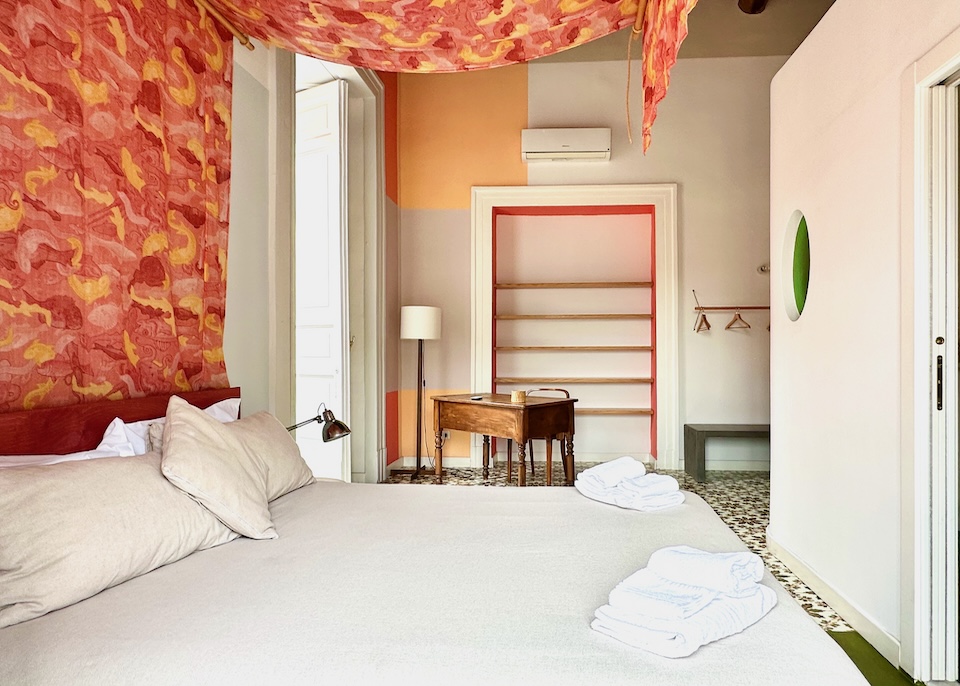
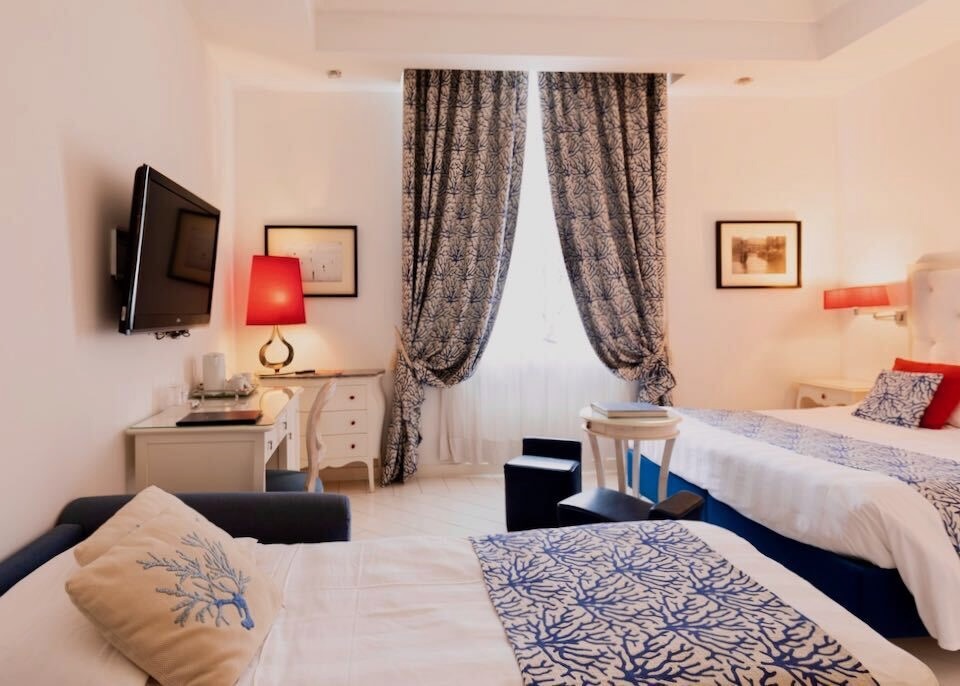
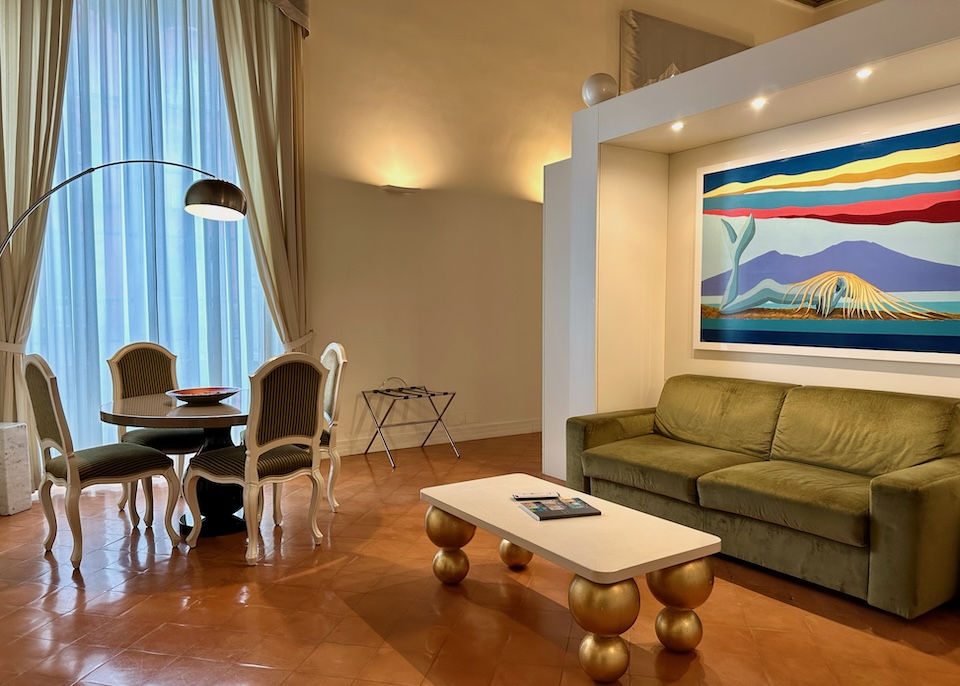


 Santorini Dave was started in 2011 when I posted a short guide to visiting Santorini with kids. Now, my site publishes regularly updated guides to
Santorini Dave was started in 2011 when I posted a short guide to visiting Santorini with kids. Now, my site publishes regularly updated guides to
Hi Dave,
Would you be able to suggest tour/activity ideas for the Amalfi Coast? We will be staying in Positano for 5 nights the 1st week of June and would like to start booking our activities. We traveled to Santorini, Mykonos and Crete last year and stayed in your top hotels and did most of the tours you recommended and had an amazing time! We are hoping you can guide us again to a fantastic vacation.
Positano itself doesn’t have any must-see sights but it’s a great place to hang out. It has a small but beautifully-sited beach and its steep streets are lined with boutiques selling colourful fashions and local ceramic ware. To explore further afield, I’d recommend a day trip to Amalfi. Easily accessible by bus, taxi, or a summer boat service, the Coast’s main town boasts a medieval cathedral (Cattedrale di Sant’Andrea) and a fascinating paper museum (Museo della Carta) housed in a 13th-century mill. From Amalfi, buses continue up to Ravello. This charming hilltop town offers sensational views and a series of delightful gardens at its two historic villas: Villa Rufolo and Villa Cimbrone. Offshore, Capri is another popular day trip. The island, which is served by regular ferries and hydrofoils, is centred on two main settlements, Capri Town and Anacapri, both of which are worth exploring. A further highlight is the Grotta Azzurra (Blue Grotto), a sea cave famous for its other-worldly blue waters. (A Capri boat tour is recommended to do everything in one day.) If you’re into hiking, the Amalfi Coast’s best-known walk is the Sentiero degli Dei (Path of the Gods). This 12km trail links Positano and Praiano, offering fabulous views as it snakes along a high ridge above the coastal towns.
Any suggestions on where to stay on Procida Island? We’d like to stay a couple of days just to relax by the sea, and thought the relative obscurity and un-touristy nature appealed to us.
Rowena
There are numerous hotels and B&Bs dotted around the northern part of the island. You could try Albergo La Vigna, a lovely four-star near the picturesque fishing village of Marina Corricella. Housed in a red hillside villa, it has elegant, simply furnished rooms, an in-house spa and, outside, its own vineyard. For beach time, your best bet would be to head over to Chiaiolella on the other (southern) side of the island.
Hello Dave,
I am planning to stay about a week with my 2 teenage kids early July in Naples.
Do you know any nice, clean and not expensive monasteries that welcome visitors?
I look forward to your reply.
Thank you very much!
Céline
To find a monastery stay I’d suggest checking monasterystays.com, an online booking service with several properties in and around Naples. Alternatively, ospitalitareligiosa.it lists a couple of religious institutions in Naples.
As to things to do in the city, I’d strongly recommend the Museo Archeologico Nazionale, a fabulous museum famous for its ancient sculpture and mosaics from Pompeii. Then there’s the Cappella Sansevero , a lavish baroque chapel, and the Certosa e Museo di San Martino, a hilltop monastery with glorious views over the bay. An easy 35-minute train ride away, Pompeii is another must-see – take the Circumvesuviana train from Piazza Garibaldi (adjacent to Stazione Centrale). Neapolitan pizza is the best in the world and you’ll find pizzerias across the city. Some of the most popular places – like Pizzeria Gino Sorbillo – draw large crowds, so be prepared to queue to get in. It’s well worth it, though. As a general rule, always go for pizzerias with a wood-fired oven (forno a legna). If you’re planning to cover a lot of sights, consider the Campania Artecard. This is a cumulative ticket which provides free and discounted admission to a long list of places and free public transport in the city. A final tip for Naples – don’t be tempted to buy a mobile phone from the sellers on the streets. Instead of the bargain of a lifetime, you’ll get home and discover you’ve bought a brick. It’s a well-known scam.
How would you compare Herculaneum and Pompeii? Have heard from friends that Herculaneum might be the better choice regarding size and crowds. Could you explain the pros and cons? Is doing both worth the effort? Will be staying for 2 nights in Naples in early September.
Both are remarkable sites, and both are easy to get to from Naples. From underneath Stazione Centrale, take the Circumvesuviana train to Ercolano Scavi for Herculaneum (about 20 minutes) or to Pompei Scavi for Pompeii (35 minutes).
Of the two sites, Pompeii is the bigger, busier and more visually impressive. Here you can see houses, temples, public baths, an amphitheatre, even a brothel (the Lupanare). Body casts lend a sinister edge to the place.
It is a big site, though, and it requires plenty of time – it’ll take you at least a morning just for the highlights. Crowds are worst at the main entrance and at the best known features but tend to thin out across the rest of the area.
Note also that in early September it’ll be quite hot, so make sure to take a hat, comfy walking shoes and bottled water. Herculaneum is a much smaller, more compact site. There are fewer ‘big’ features but the houses are better preserved than at Pompeii and there are some wonderful frescoes. It’s also less tiring than its better known neighbour and it attracts far fewer people. You can do both on a day trip from Naples – buy a combined ticket – but be ready for a very full day.
Whichever you go to, try to find time for the Museo Archeologico Nazionale in Naples. One of Italy’s best archaeological museums, it displays many exhibits from Pompeii, including a series of awesome mosaics.
hi dave,
I was wondering if you had any suggestion for Amalfi Coast hotels?
A couple of recommendations. About a kilometre from Amalfi, the historic Santa Cristina is one of the best hotels on the coast. A luxury five-star, it occupies a handsome Liberty-style villa, offering summery majolica-tiled rooms, magnificent sea views, and private access to the sea. For a more lofty location, the Belmond Hotel Caruso is a great option in hilltop Ravello – for years the hometown of writer Gore Vidal. It has elegantly attired rooms in a restored 11th-century palazzo, an extraordinary infinity pool, and sensational coastal views.
We are an older couple that has a little trouble getting around. Walking more than a few hundred feet becomes a problem but love being right in the heart of lively neighborhoods. Could you recommend a hotel in Naples within a short walk of good restaurants and cafes. Budget not an issue: 3 star, 4 star, or 5 star hotels are fine as long as close to street life and buzz.
Two suggestions, both in Naples’ buzzing historic center. Hotel Piazza Bellini is a lovely boutique hotel on Piazza Bellini, a handsome cafe-clad square in the heart of the action. It’s housed in a 16th-century palazzo but rooms are furnished in a contemporary minimalist style. Also in the historic center is the Decumani Hotel de Charme. Occupying a former Cardinal’s palace, it has elegant rooms, period furniture, and a stunning salon. The surrounding area is fascinating with its cobbled lanes, Dickensian street life and pretty, though somewhat faded, piazzas. You’ll also have your choice of trattorias, cafes, and some of Naples’ most celebrated pizzerias.